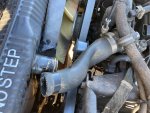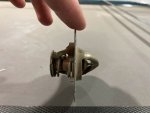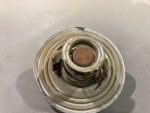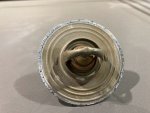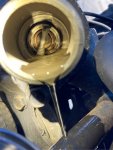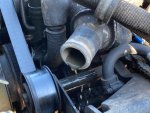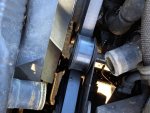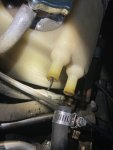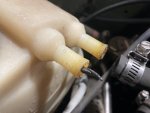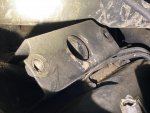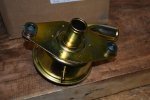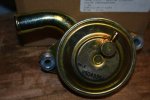More infos!
So as I walk this path of endless maintenance, I decided to tackle my cooling system the other day. I'll report on some findings here in case some other soul stumbles across this during their cooling system endeavors.
Problem:
As I'm driving, the temp gauge would consistently get to 220F and the engine would operate at that temperature. It's on the hot side in my opinion, although I haven't verified with a laser temp gun (it's on the way). As far as I understand, you want it to be close to 200F for a diesel, so around 195-205 would calm me down inside.
Findings:
The first thing I did was completely flush everything out of the system (I think). I opened the drain valve at the bottom of the truck on the radiator line, and drained as much of the old garbage out as I could. I then started filling the system with a garden hose and repeatedly draining until I was getting clear water out of it. Then I did it some more. I had the heater running during this as well so as to flush that system somewhat too.
After doing this for about an hour, I drove around to watch the temps, aaaand they would stay the same, around 220F on the gauge.
So the next thing I did was check the coolant tank fittings/lines for obstructions.
@Retiredwarhorses posted this somewhere at some point and I vaguely remembered what was written, so I did what I recalled reading. Remove the 2 small lines connecting to the plastic tank, and make sure the nipples are clear of obstructions. I did this and found some sort of silicone jammed in one of them. The next thing I checked was to blow through either of those lines, and hear air come out the other, both passed this check.
I then re-assembled the system, went for a drive, and the same results prevailed
So onwards with my troubleshooting. I figured it was possible that the thermostat was stuck closed after years of sitting. I removed the top radiator hose, and then the thermostat housing. Thermostat came out easy and didn't look corroded at all. It did however look nothing like the photos I have seen of 6.5L engine thermostats. I'll attach some pictures, but I have no idea what this one is. As far as I understand, the 6.5L engine thermostat has a little rubber circle on it and looks very different.
Anyway, I re-assembled the system without the thermostat, that way I could see what temp it gets to with maximum flow. Same results, but it took much longer to get to 220F, so I know it's not the thermostat (probably).
And my last effort - The
Cadillac valve. I checked this last, because I thought my fan clutch was already stuck completely closed. Every time I have ran the truck, the fan has ran 100% of the time. What I did
not realize, is that the clutch was only partially closed, and the fan was not running at its maximum speed at any point. I figured this out by disconnecting electrical power to the valve, and then suddenly seeing the fan ramp up to at least double the speed it was turning at.
With this new discovery, I took the truck for a drive with the valve's power disconnected. Success! The temp maximized around 185-190F the entire time. So at this point, I've at least got the problem narrowed down to what I think is a faulty fan clutch.
Plenty of pictures attached for the curious.




